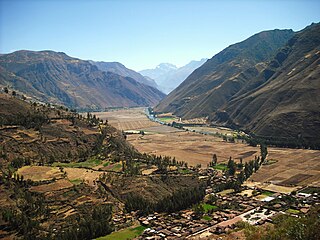
Andean music is a group of styles of music from the Andes region in South America.

Chicha is a fermented (alcoholic) or non-fermented beverage of Latin America, emerging from the Andes and Amazonia regions. In both the pre- and post-Spanish conquest periods, corn beer made from a variety of maize landraces has been the most common form of chicha. However, chicha is also made from a variety of other cultigens and wild plants, including, among others, quinoa, kañiwa, peanut, manioc, palm fruit, rice, potato, oca, and chañar. There are many regional variations of chicha. In the Inca Empire, chicha had ceremonial and ritual uses.

The Sacred Valley of the Incas, or the Urubamba Valley, is a valley in the Andes of Peru, north of the Inca capital of Cusco. It is located in the present-day Peruvian region of Cusco. In colonial documents it was referred to as the "Valley of Yucay". The Sacred Valley was incorporated slowly into the incipient Inca Empire during the period from 1000 to 1400.

La República is a Peruvian newspaper based in Lima, Peru. It is one of the two main national daily newspapers sold all over the country since it was founded on November 16, 1981.
Chicha Press is a Peruvian nickname for sensationalist tabloid newspapers that first emerged in the 1980s. The etymology of Chicha Press is derived from the name for certain drinks made from corn, which later came to be used by some in Peru describe the culture of Andean migrants to the capital region of Lima during the 1960s. The concept of Chicha press became a central part of the national culture in 2000 when it was popularized by Alberto Fujimori to discredit opponents of his government in the general elections of 2000.
Tecnocumbia is a style of Cumbia where there is a fusion between electronic sounds generated by electronic musical instruments through electronic drums, the electric guitar, synthesisers, and samplers. "Tecnocumbia" was a word developed in Mexico to describe this type of music. However, the style of music was developed throughout South America with different names given to it before the name "Tecnocumbia" was adopted as the single denomination for the music.

Condesuyos Province is one of eight provinces in the Arequipa Region of Peru. Its seat is Chuquibamba.

San Pedro de Larcay is one of 11 districts of the Sucre Province in the Ayacucho region in Peru.
Chichas District is one of eight districts of the province Condesuyos in Peru.

Karen Dejo is a Peruvian actress and dancer. She has appeared in numerous Latin American television presentations.
Cecilia Bracamonte Chocano is a Peruvian singer. Her music genre is mainly Peruvian waltz which is the music heard in the main coastal cities. Her singing career spans more than four decades.

Chicha morada is a beverage originated in the Andean regions of Perú but is currently consumed at a national level.
Peruvian cumbia is a subgenre of chicha that became popular in the coastal cities of Peru, mainly in Lima in the 1960s through the fusion of local versions of the original Colombian genre, traditional highland huayno, and rock music, particularly surf rock and psychedelic rock. The term chicha is more frequently used for the pre-1990s variations of the subgenre.

Chicha de jora is a corn beer or chicha prepared by germinating maize, extracting the malt sugars, boiling the wort, and fermenting it in large vessels for several days. The process is essentially similar to the process for the production of European-style beer. Some add quinoa or other adjuncts to give it consistency before it is boiled down. Chancaca, a hard raw form of cane sugar, helps with the fermentation process.
Ángel Aníbal Rosado Garcîa was a Peruvian composer and musician.
Jinkiori or Jingkiori is an archaeological site consisting of petroglyphs engraved in a big rock called the “Monolith of Jinkiori". It is located in Paucartambo Province, region of Cusco, Peru.
Chicha Libre is a Brooklyn-based six-member band founded by Olivier Conan. Its name is a reference to chicha, a corn-based liquor that has been produced in South America since the time of the Incas. It is also the name of a Peruvian musical genre on which the band's music is based.
On the Cerro Baúl mesa, in the central highlands of Peru, elite women from the Wari Empire made a drink called chicha in the years before 600 AD.
The Los Angeles League of Musicians, often abbreviated as LA LOM, is an American instrumental band originating from Los Angeles, California. The band consists of guitarist Zac Sokolow, bassist Jake Faulkner, and percussionist Nicholas Baker. The trio began playing together at the Hollywood Roosevelt Hotel, where they experimented with a mix of distinct genres, including surf guitar, cumbia, and Peruvian chicha. The band has been noted for its fusion of multiple different styles.









